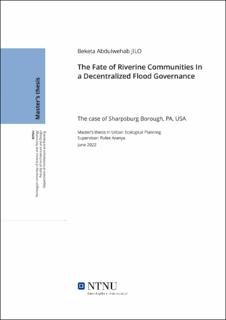| dc.description.abstract | Abstract
Flooding used to be the major threat of natural disasters in the world between 1970 and 2005, and it continued to be the largest number of reported natural disasters in 2019(Ritchie, H. and Roser, M., 2014). Pennsylvania ranks in the top five states for inland flooding threats, where 430,000 people live in flood-prone areas. The threats are projected to increase by 40% in the coming nearly 30 years (States at Risk, 2015). Among those, riverine borough communities are highly vulnerable due to the high possibility of inundation from rivers, creeks, and storms. Sharpsburg is one of the riverine boroughs found in Allegheny County, south-western PA. It has about 3446 inhabitants living in a structure built before 1965 along the Allegheny River, where 34 % of the structure is found in the flood plain (Sharpsburg Community vision plan, 2019).
However, the existing decentralized approach to managing water in Allegheny County may currently represent a barrier to making the kinds of changes that will be necessary to protect places like Sharpsburg. Allegheny County is one of the most politically fragmented areas in the United States, with 130 municipalities located within less than 2,000 km², and these local governments are able to make their own independent decisions about land use and flood management concerns. Research shows that adaptive flood governance: a self-organizing process of a social-ecological system that changes form as systems undergo periods of crises and stability, became an effective approach to coping with uncertainty and realizing resilience to flooding (Chaffin & Gunderson 2016, p. 83). In this project, Sharpsburg's flood governance challenges will be assessed. In addition, methods for public and private stakeholders to address flooding vulnerability through an adaptive governance system will be analyzed. In this study, it is shown that a top-down government that relies more on national solutions that lack details about the local context could have a negative impact on the community due to uninformed risk and a lack of contextualized solutions.
The empirical data shows that, for a small municipality like Sharpsburg with scarce resources, an uncoordinated and reactive flood management strategy would hamper selforganization; however, the recommended adaptive governance framework could help the borough to self-organize through a defined structure of cooperation among stakeholders and be adaptive to uncertain future events. These can help turn the fate of Sharpsburg towards resilience and sustainability. | |
